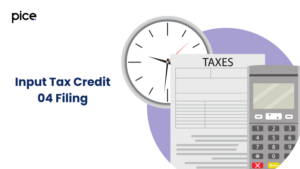Address of Delivery in GST
- 20 Sep 24
- 11 mins

Address of Delivery in GST
Key Takeaways
- The Address of Delivery is crucial for determining the GST implications and the correct tax levy for both the supplier and recipient of services.
- Understanding the Time of Issue, Place of Supply, and Value of Supply is essential for GST compliance and the efficient management of tax liabilities.
- The Place of Supply is fundamental in determining the applicable GST rate and ensuring the correct allocation of tax revenue between jurisdictions.
- Accurate determination of the Value of Supply is critical for issuing compliant invoices and calculating the correct GST amount for both suppliers and recipients.
- The Place of Supply rules vary for goods and services, affecting domestic, B2B, and inter-state transactions, and are key to applying GST correctly.
What is Address of Delivery in GST?
In the Goods and Services Tax (GST) framework in India, the concept of "Address of Delivery" plays a pivotal role, especially when it comes to the dynamics between the recipient of services and the supplier of services. This address, where the goods are physically delivered or the services are rendered, is crucial for determining the place of supply. This determination directly influences the tax implications—whether Central GST (CGST) and State GST (SGST) or Integrated GST (IGST) is applicable. For both the recipient of services and the supplier of services, the Address of Delivery is particularly significant in transactions involving the movement of goods from one state to another or within the same state, affecting the determination of the correct tax levy.
Why are Time, Place, and Value of Supply Important?
Time of Issue, Place of Supply, and Value of Supply are the three main parts of the GST framework. They are very important for figuring out who owes tax, making sure everyone follows the rules, and making sure that tax credits can move freely through the economy. Understanding these ideas is important for both the person receiving services and the person providing services.
Time of Issue/ Time of Delivery

The "Time of Issue" is a cornerstone in the GST framework, dictating the exact moment when the liability to pay GST arises. This idea is important for both the person providing the service and the person receiving it because it has a direct effect on paying taxes. When you know the Time of Issue, you can figure out when your GST payments are due. This helps both suppliers and recipients better handle their cash flows and avoid penalties for paying late.
For the supplier of services, accurately identifying the Time of Issue is essential for issuing timely invoices and for the recipient of services, it's crucial for claiming input tax credits within the stipulated time frames. The Time of Issue also aids in accurate tax filing, aligning the tax liabilities with the correct tax periods, thereby preventing discrepancies during tax audits.
Place of Supply
The "Place of Supply" holds paramount importance in determining which jurisdiction's GST applies to a transaction. This determination is crucial for ensuring that GST is correctly applied, whether it involves CGST/SGST or IGST, particularly affecting domestic transactions and inter-state transactions. For the supplier of services, identifying the correct Place of Supply is essential to charge the appropriate GST rate, while for the recipient of services, it determines the eligibility and correctness of input tax credit claims.

The Place of Supply affects how taxes are allocated between states, ensuring that revenue goes to the correct jurisdiction, which is vital for maintaining the integrity of India’s fiscal federalism under GST. This concept is especially significant in the context of services, where the physical location of goods does not always determine the tax jurisdiction.
Value of Supply

The "Value of Supply" is the taxable value on which GST is calculated. It is fundamental for both the supplier of services and the recipient of services as it forms the basis for tax calculation. The Value of Supply includes the transaction value of goods or services, inclusive of any taxes, fees, charges, and discounts applied. For suppliers, accurately determining the Value of Supply is crucial for issuing compliant invoices and for calculating the correct amount of GST to charge.
For recipients, it determines the amount of GST they can claim as input tax credit, directly impacting their tax liability and operational costs. Ensuring the correct Value of Supply is reported helps in uniform taxation across similar transactions, promoting fairness and transparency in the tax system.
In summary, the Time of Delivery/ Issue, Place of Supply, and Value of Supply are integral to the GST framework, ensuring that taxes are levied accurately and fairly. They enable both the supplier of services and the recipient of services to comply with GST regulations, manage the payment of taxes efficiently, and maintain the seamless flow of input tax credits. These concepts are designed to prevent tax evasion, double taxation, or non-taxation of supplies, thereby supporting the integrity and efficiency of the GST system for all stakeholders involved in domestic transaction and inter-state transactions.
Place of Supply
General Principle
The Place of Supply determines whether a transaction is subject to Central GST (CGST) and State GST (SGST) or Integrated GST (IGST). This distinction is pivotal for ensuring that GST is correctly applied and that the revenue is allocated to the appropriate jurisdiction, which is essential for maintaining the integrity of India’s fiscal federalism under GST.
Place of Supply for Goods
- When There is Movement of Goods: For goods that are transported from one location to another, the Place of Supply is where the goods are delivered to the recipient. This rule is straightforward and is particularly relevant for determining whether a transaction is an inter-state transaction, affecting whether IGST or CGST/SGST is applied.
- No Movement of Goods: In scenarios where the sale or transfer of goods does not involve their movement (e.g., goods sold from a warehouse), the Place of Supply is the location of the goods at the time of the sale. This scenario often applies to domestic transactions where the goods are sold within the same state.
- Goods Supplied on a Vessel/Conveyance: For goods supplied to the recipient on board a conveyance, such as a ship, aircraft, or train, the Place of Supply is the location at which the goods are taken on board. This rule simplifies tax implications for goods sold during transit.
Place of Supply for Services
- General Rule: The Place of Supply for services is typically the location of the recipient of services. However, there are several exceptions based on the nature of the service provided, such as services related to immovable property, events, and transportation.
- B2B Transactions: For B2B transactions, the Place of Supply is where the recipient of services is registered. This rule facilitates the correct levy of GST and the seamless flow of input tax credits among business entity.
- Inter-State and Intra-State Transactions: Determining the correct Place of Supply helps in distinguishing between inter-state and intra-state transactions, which is crucial for applying the correct GST rate (IGST vs. CGST/SGST) and for the accurate distribution of tax revenue between states.
Special Cases
- Imports and Exports: The Place of Supply for imports is the location of the importer, making the transaction subject to IGST. For exports, the Place of Supply is considered outside India, allowing these transactions to be treated as zero-rated supplies under GST law.
- E-Way Bill: In cases where an e-way bill is required for the movement of goods, the details of the Place of Supply must be accurately mentioned to comply with GST regulations and facilitate the tracking of goods across state lines.
Understanding the Place of Supply is essential for both the supplier of services and the recipient of services to ensure compliance with GST laws, accurately calculate taxes, and facilitate the proper allocation of tax revenue. It affects every aspect of GST, from the issuance of invoices to the filing of returns, and is fundamental for the smooth operation of the GST system across domestic transactions, B2B transactions, and inter-state transactions.
💡If you are looking for ways to pay your GST bill with credit card, then download Pice Business Payment App. Pice is a one stop app for all business payments.
 By
By 
















